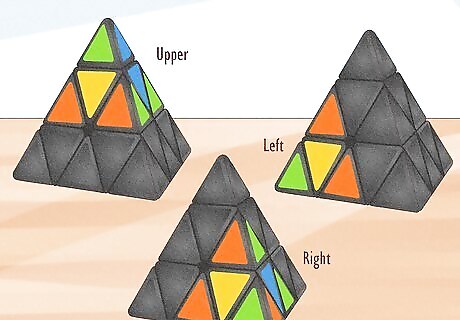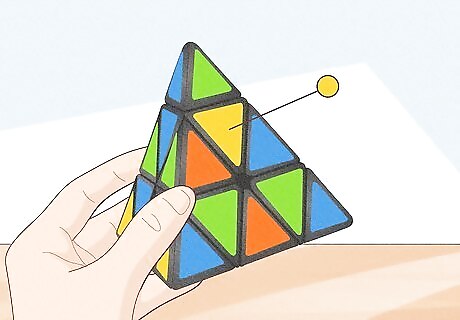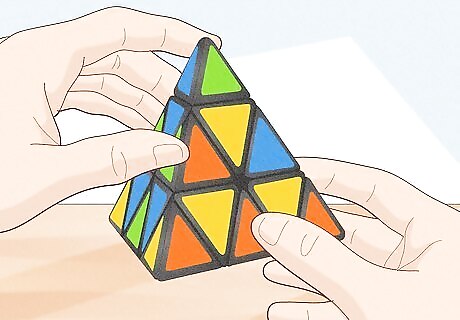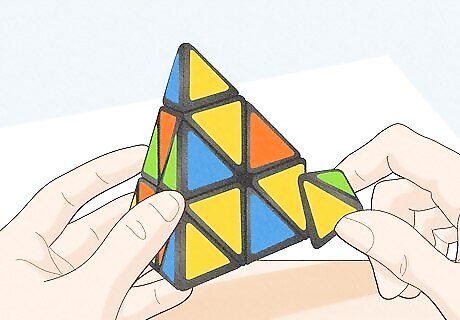
views
Learning the Terms

Understand the terms. There are three terms used to describe the individual pieces that make up each Pyraminx face: Centers: Center pieces are located in the center of each axial piece. There are four axial pieces, which give us three centers on each side. Since there are four sides to the Pyraminx, we have twelve centers total. Centers do not move, as they cannot change positions to a different type of piece. Edges: Edge pieces are located to the left and right of the top centers and between the bottom two centers on each face. There are six edge pieces total as each side will share common edges due to the freely movable axial parts that can change each edge’s positions to a completely different side of the Pyraminx. Tips: Tip pieces are most outer points of the triangular pyramid. These pieces can be independently moved and are not as significant in solving the puzzle. However, these pieces must still be twisted into the correct positions to achieve the final solution.

Learn the notations. To understand the actions and sequences performed, you must be familiar with the following notations used to describe the different rotations of the Pyraminx: R: R stands for the right part of the Pyraminx face you are looking at. When this notation is used, the right must be turned clockwise. R’: Again, for the right part, only this time it must be turned in the counterclockwise direction. L: L stands for the left part of the Pyraminx face in front of you. When this notation is used, the left part must be turned clockwise. L’: L’ represents turning the left part counterclockwise. U: U stands for the upper or top part of the Pyraminx that must be turned clockwise U’: U’ represents turning the upper part of the Pyraminx in a counterclockwise direction.
Solving the First Layer

Choose a face. As a beginner, choosing to begin with the yellow-colored face is most common and highly recommended. Although you can solve the Pyraminx by starting with any color, yellow is highly recommended as it is similar to the white face of the Rubik's cube. It will also be less confusing since this guide uses the yellow face to begin solving.

Align the Centers. Starting with the scrambled Pyraminx, we need to align our three centers until they all match colors. Find any side that has yellow as the top center. Perform the following actions: R, R, R, and L, L, L. Note: If you can get the other two yellow centers in less than three turns, then continue to the next step If you have performed the three turns for both the right and left pieces but have not gotten matching centers, turn the top piece counterclockwise(U’) and repeat the actions. Perform U’ once more if the centers still haven’t matched up on the second attempt. You will be guaranteed to get the yellow centers aligned on the third try because turning the top piece after this will place you back at the original side you began with.

Align the tips. This is a relatively simple step. Twist the three tips in any direction at the yellow face until they match the yellow centers. There is one more tip, towards the back of the Pyraminx, away from the yellow side. This tip will not have yellow since we have already solved our yellow tip pieces. Match the last tip colors with the other colored centers around it.

Solve the edges. At this point, your centers and tips must all be yellow. The only thing left to solve now is the yellow face's edge pieces. Turn the entire Pyraminx so that the yellow face is on the bottom side, now the base of the Pyraminx. Look at the three different colored sides of the Pyraminx and locate the unsolved yellow edge pieces. Now, look at the other color on the same edge as the yellow color. Depending on the other color, check if the center below it is the same color. If it isn’t, turn the top piece either clockwise or counterclockwise to get it lined up with the matching color. Turn the Pyraminx so that you are facing the side where the other color has been matched up with its colored bottom center. The yellow edge piece will either be on the left or right side from the front face. If it is on the left side: R, U’, R’ If it is on the right side: L’, U, L Repeat these steps to solve the remaining edge pieces. If done correctly, the first layer will be solved entirely. You will have the yellow face complete (which was on the bottom), and the bottom layer of the other three faces will be all blue, red, and green for each side. Special Case: When solving the edges, you may encounter an unsolved yellow piece in the bottom layer of the other three faces. If this occurs, complete all the edge pieces in the top layer FIRST. Once you have done that, and the edge piece is still in the bottom layer, we need to move it out of that position to get it in the top layer. You can do this by performing either of the moves listed above. Once the yellow edge piece is relocated, follow the normal steps to complete the first layer.




















Comments
0 comment